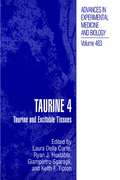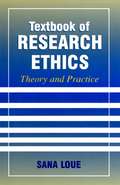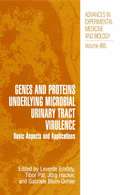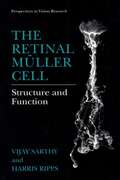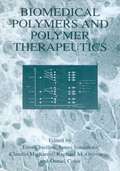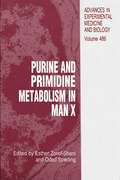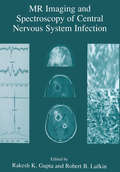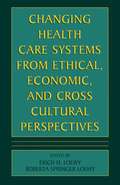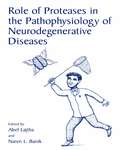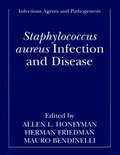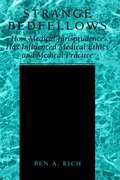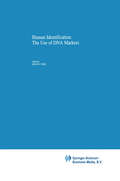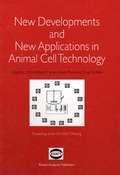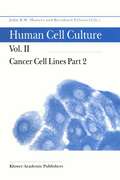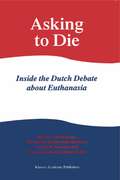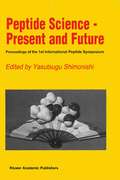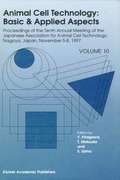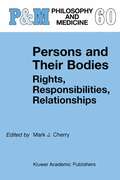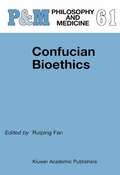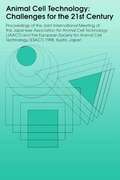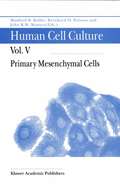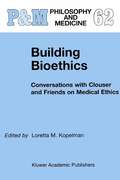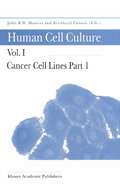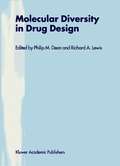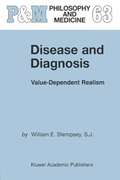- Table View
- List View
Taurine 4: Taurine and Excitable Tissues (Advances in Experimental Medicine and Biology #483)
by Ryan J. Huxtable Giampietro Sgaragli Keith F. Tipton Laura Della CorteMitochondria from mammalian tissues possess an elaborate system for 2+ 2+ transporting Ca across their inner membrane which consists of Ca import, 2+ via the Ca uniporter, in response to the mitochondrial membrane 2+ + potential ?? and of Ca release by an antiport system in exchange for H + 9,23 or Na (see Fig. l) . Because the uniporter is dependent upon the external 2+ 2+ 2+ 2+ Ca concentration ([Ca ]), mitochondria accumulate Ca until the [Ca ] o o 2+ decreases to the level at which the uniporter activity balances the Ca efflux. 2+ The [Ca ] at which the uniporter and efflux activities are equal is defined o the “setpoint” andcorresponds to values between 0.3-3µM. 2+ Figure 1. The Ca transport system of the inner membrane of mammalian mitochondria. U, + 2+ + + uniporter. I, Na -independent efflux mechanism or Ca /2H exchanger. D, Na -dependent 2+ + efflux mechanism or Ca /2Na exchanger. PTP, permeability transition pore. FP, 11 flavoprotein. ?? membrane potential. ? pH gradient. Adapted from .
Textbook of Research Ethics: Theory and Practice (Law And Philosophy Library)
by Sana LoueThis textbook provides a brief history of human experimentation and reviews various theories of ethics from which the principles and rules that govern this research are derived. All relevant international documents and national regulations, policies and memoranda are referred to extensively to assist in addressing issues that regularly arise during the course of research involving human subjects. It includes case examples and exercises and is of interest to students and experienced researchers.
Genes and Proteins Underlying Microbial Urinary Tract Virulence: Basic Aspects and Applications (Advances in Experimental Medicine and Biology #485)
by Gabriele Blum-Oehler Jörg H. Hacker Tibor Pál Levente EmodyProceedings of the FEMS Symposium on Genes and Proteins Underlying Microbial Urinary Tract Virulence: Basic Aspects and Applications, held September 16-19, 1999, in Pécs, Hungary. Urinary tract infections are among the most frequent diseases caused by microbial pathogens. In this volume, researchers, clinical microbiologists and clinicians exchange the latest ideas covering four major aspects of this important topic: Genetic information, synthesis and assembly of virulence factors in urinary pathogens; Regulation of genes involved in the phenotypic appearance of virulence; Host-parasite interactions determining the process and outcome of the infection; Possible applications of the above aspects in diagnosis, therapy and prevention.
The Retinal Müller Cell: Structure and Function (Perspectives in Vision Research)
by Vijay Sarthy Harris RippsThe human brain contains more than a billion neurons which interconnect to form networks that process, store, and recall sensory information. These neuronal activities are supported by a group of accessory brain cells coll- tively known as neuroglia. Surprisingly, glial cells are ten times more - merous than neurons, and occupy more than half the brain volume (Hydén, 1961). Although long considered a passive, albeit necessary, component of the nervous system, many interesting and unusual functional properties of glial cells are only now being brought to light. As a result, the status of these cellular elements is approaching parity with nerve cells as a subject for experimental study. The term glia (or glue) seems today to be a misnomer in view of the diverse functions attributed to glial cells. Experimental studies in the last three decades have clearly established that the behavior of glial cells is far from passive, and that they are at least as complex as neurons with regard to their membrane properties. In addition, glial cells are of importance in signal processing, cellular metabolism, nervous system development, and the pathophysiology of neurological diseases. The Müller cell of the ver- brate retina provides a splendid example of an accessory cell that exhibits features illustrating every aspect of the complex behavior now associated with glial cells.
Biomedical Polymers and Polymer Therapeutics
by DanielCohn Raphael M. Ottenbrite ClaudioMigliaresi JunzoSunamoto EmoChielliniProceedings of the Third International Symposium on Frontiers in Biomedical Polymers including Polymer Therapeutics: From Laboratory to Clinical Practice, held May 23-27, 1999, in Shiga, Japan. This book focuses on the progress and unique discoveries in the interdisciplinary scientific and technological area of biomedical application of polymers. The topics include polymeric materials for biomedical and pharmaceutical applications, as well as polymeric materials in therapeutics.
Purine and Pyrimidine Metabolism in Man X (Advances in Experimental Medicine and Biology #486)
by Esther Zoref-Shani Oded Sperlingth This volume contains articles presented at the X International Symposium on Purines and Pyrimidines in Man, held on May 14 19, 2000 in Tel Aviv, Israel. The first symposium in this series took place in Tel Aviv in 1973. Since then, the symposium has been held every three years in different parts of the world, including Europe, USA and Japan. The participants, in this series of symposia, are characterised by a wide interest in the various aspects of purines and pyrimidines in man, which include biochemistry, genetics, pharmacology, physiology, clinics, etc. Presentations in the symposia include clarification of metabolic pathways, characterisation of enzyme structure and kinetics and discoveries of new inborn errors of metabolism and suggestions for new therapeutic approaches for these inborn errors. In addition, development of new purine and pyrimidine derivatives for the treatment of cancer and viral diseases, and many more subjects of mutual interest were brought to the fore. With the development of therapeutic means and of new research tools, we have witnessed changes in the areas of interest. The interest in gout and uric acid urolithiasis has lessened, whereas molecular aspects, the role of purine and pyrimidine substances in neurotransmission and in purinergic signaling appear to gain greater interest. The articles, included in this volume, contain new data pertaining to the various aspects detailed above.
MR Imaging and Spectroscopy of Central Nervous System Infection
by Rakesh K. Gupta Robert B. LufkinCentral nervous system (CNS) infections continue to pose a serious problem in health care even with improved knowledge and treatment. Despite the introduction of newer antimicrobial agents and diagnostic techniques, the morbidity and mortality associated with CNS infections remain high. The morbidity associated with CNS infections may be even more important than the death rate especially in developing countries as neurological sequelae may deprive the survivors of intellect and physical ability, demeaning the quality of life and burdening health resources and social services. MR imaging is an important integral part of the protocol for the management of CNS infections and MR spectroscopy is increasingly being utilized in its management. This work is an attempt to provide a comprehensive review of imaging and spectroscopy of the commonly encountered CNS infections in the clinical practice in developing and developed countries. The first chapter deals with basic physical principles of MR imaging and spectroscopy that will help beginners to understand the technical terms used in subsequent chapters. The remaining 10 chapters deal with clinical, pathological, MR imaging and spectroscopy features and their applications in CNS infections. This will help in giving a comprehensive understanding to readers with a background in clinical, radiological, basic MRI, and neurological sciences. The T2 hypointense lesions are a real diagnostic dilemma especially in developing countries for which an algorithm has been suggested in the concluding chapter.
Changing Health Care Systems from Ethical, Economic, and Cross Cultural Perspectives
by Erich E. H. LoewyThis volume is the result of a conference sponsored by the Medical Alumni Association of the University of California, Davis and held in Sacramento, California, in January, 2000, The purpose of this conference was to examine the impact ofvarious health care structures on the ability of health care professionals to practice in an ethically acceptable manner. One of the ground assumptions made is that ethical practice in medicine and its related fields is difficult in a setting that pays only lip service to ethical principles. The limits of ethical possibility are created by the system within which health care professionals must practice. When, for example, ethical practice necessitates—as it generally does—that health care professionals spend sufficient time to come to know and understand their patients’ goals and values but the system mandates that only a short time be spent with each patient, ethical practice is made virtually impossible. One of our chief frustrations in teaching health care ethics at medical colleges is that we essentially teach students to do something they are most likely to find impossible to do: that is, get to know and appreciate their patients’ goals and values. There are other ways in which systems alter ethical possibilities. In a system in which patients have a different physician outside the hospital than they will inside, ethical problems have a different shape than if the treating physician is the same person.
Role of Proteases in the Pathophysiology of Neurodegenerative Diseases
by Abel Lajtha Naren L. BanikResearchers seeking problems that offer more hope of success often avoid subjects that seem to be difficult to approach experimentally, or subjects for which experimental results are difficult to interpret. The breakdown part of protein turnover in vivo, particularly in nervous tissue, was such a subject in the past – it was difficult to measure and difficult to explore the mechanisms involved. For factors that influence protein metabolism, it was thought that protein content, function, and distribution are controlled only by the synthetic mechanisms that can supply the needed specificity and response to stimuli. The role of breakdown was thought to be only a general metabolic digestion, elimination of excess polypeptides. We now know that the role of breakdown is much more complex: it has multiple functions, it is coupled to turnover, and it can affect protein composition, function, and synthesis. In addition to eliminating abnormal proteins, breakdown has many modulatory functions: it serves to activate and inactivate enzymes, modulate membrane function, alter receptor channel properties, affect transcription and cell cycle, form active peptides, and much more. The hydrolysis of peptide bonds often involves multiple steps, many enzymes, and cycles (such as ubiquination), and often requires the activity of enzyme complexes. Their activation, modification, and inactivation can thus play an important role in biological functions, with numerous families of proteases participating. The specific role of each remains to be elucidated.
Staphylococcus aureus Infection and Disease (Infectious Agents and Pathogenesis)
by Allen Honeyman Herman Friedman Mauro BendinelliStaphylococcus aureus is now acknowledged as being the most important bacterial pathogen of humans. It usually produces localized disease but can be rapidly invasive, spreading through the tissues, invading bone, and seeding the bloodstream to produce a fulminant picture of septic shock, disseminated intravascular coagulation, and rapid death. Moreover, most strains of staph infections are becoming resistant to most antibiotics, thus posing a significant problem for hospitals and health care facilities. This book, a volume in the Infectious Agents and Pathogenesis series, presents chapters by the major researchers in the field.
Strange Bedfellows: How Medical Jurisprudence Has Influenced Medical Ethics and Medical Practice
by Ben A. RichThe pervasive influence of law on medical practice and clinical bioethics is often noted with a combination of exasperation and lamentation. Physicians and non-physician bioethicists, generally speaking, consider the willingness of courts, legislatures, and regulatory agencies to insinuate themselves into clinical practice and medical research to be a distinctly negative aspect of contemporary American society. They are quick to point out that their colleagues in other Western developed nations are not similarly afflicted, and that the situation which obtains elsewhere is highly preferable to the legalization and purported over-regulation of medicine that has taken place in the United States during the last fifty years. In this book I offer a decidedly different perspective. It is, admittedly, not entirely without personal and professional bias. Prior to becoming a fu- time academic, teaching bioethics in the setting of an academic medical center, I was, for nearly 20 years, an attorney specializing in health law. Even after earning a doctorate in philosophy, I was frequently considered to be the “resident lawyer” on the bioethics faculty, much more frequently looked to for my insights on the law than my perspective as one who had formally studied moral philosophy and applied ethics. I note this not out ofa sense of frustration or disappointment, but as confirmation that even among physicians and n- physician bioethicists, there is widespread recognition that the law does have important contributions to make in assessing the practice ofmedicine and the conduct of medical research.
Human Identification: The Use Of Dna Markers (Contemporary Issues in Genetics and Evolution #4)
by B. S. WeirThe ongoing debate on the use of DNA profiles to identify perpetrators in criminal investigations or fathers in paternity disputes has too often been conducted with no regard to sound statistical, genetic or legal reasoning. The contributors to Human Identification: The Use of DNA Markers all have considerable experience in forensic science, statistical genetics or jurimetrics, and many of them have had to explain the scientific issues involved in using DNA profiles to judges and juries. Although the authors hold differing views on some of the issues, they have all produced accounts which pay due attention to the, sometimes troubling, issues of independence of components of the profiles and of population substructures. The book presents the considerable evolution of ideas that has occurred since the 1992 Report of the National Research Council of the U.S. Audience: Indispensable to forensic scientists, laying out the concepts to all those with an interest in the use of genetic information. The chapters and exhaustive bibliography are vital information for all lawyers who must prosecute or defend DNA cases, and to judges trying such cases.
New Developments and New Applications in Animal Cell Technology: Proceedings of the 15th ESACT Meeting
by Otto-Wilhelm Merten Pierre Perrin Bryan GriffithsAnimal cell technology is becoming an increasingly important part of biotechnology and many products are now used in human health care and for veterinary applications. However, there are many times more products actually in the developmental pipelines of the biotechnology industry, including various phases of clinical trials. The Proceedings of the 15th Meeting of the European Society for Animal Cell Technology (Tours, France, September 1997) presents the actual current state as well as New Developments and Applications in Animal Cell Technology for the benefit of society. These Proceedings represent both the current state and applications of animal cell technology and the way the technology is expanding into new areas to give a unique insight into new products and applications for human and animal health care.
Cancer Cell Lines Part 2 (Human Cell Culture #2)
by John Masters Bernhard Ø. PalssonContinuous cell lines derived from human cancers are the mostwidely used resource in laboratory-based cancer research. The first 3 volumes of this series on Human Cell Culture are devoted to these cancer cell lines. The chapters in these first 3 volumes have a common aim. Their purpose is to address 3 questions offundamental importance to the relevanceof human cancer cell lines as model systems of each type of cancer: 1. Do the cell lines available accurately represent the clinical presentation? 2. Do the cell lines accurately represent the histopathology of the original tumors? 3. Do the cell lines accurately represent the molecular genetics of this type of cancer? The cancer cell lines available are derived, in most cases, from the more aggressive and advanced cancers. There are few cell lines derived from low grade organ-confined cancers. This gap can be filled with conditionally immortalized human cancer cell lines. We do not know why the success rate for establishing cell lines is so low for some types of cancer and so high for others. The histopathology of the tumor of origin and the extent to which the derived cell line retains the differentiated features of that tumor are critical. The concept that a single cell line derived from a tumor at a particular site is representative oftumors at that site is naïve and misleading.
Asking to Die: Inside The Dutch Debate About Euthanasia
by David C. Thomasma Thomasine Kimbrough-Kushner Gerrit K. Kimsma Chris Ciesielski-Carlucciclaim was that he had faced a conflict of duties pitting his legal duty not to kill against his duty as a physician to relieve his patient’s unbearable suffering. He was acquitted on the important grounds of conflict of duty. These grounds are based on a concept in Dutch law called "force majeure" 4 which recognizes extenuating circumstances such as conflicts of duty. The acquittal was upheld by the Lower Court of Alkmaar, but revoked by an Amsterdam court of appeal. The case went on to the Supreme Court, but before the Supreme Court's decision was issued, the Royal Dutch Medical Association (RDMA) attempted to clarify the criteria for euthanasia that many within the profession already accepted. The RDMA proposed that physicians be permitted to perform euthanasia provided that a set of procedures had been met. Variously stated, the guidelines contain the following central provisions: Voluntary, competent, explicit, and persistent requests on the part of the • patient; Requests based on full information; • The patient is in a situation of intolerable and hopeless suffering (either • physical or mental); No further acceptable alternatives to euthanasia. All alternatives • acceptable to the patient for relief of suffering having been tried; Consultation with at least one other physician whose judgment can be • 5 expected to be independent. Indirectly, these guidelines became the criteria prosecutors used to decide whether or not to bring charges.
Peptide Science — Present and Future: Proceedings of the 1st International Peptide Symposium
by Yasutsugu ShimonishiIn the late 1980s, Peptide Societies were established in Europe, the United States, and Japan, and more recently, in the Asian and the Pacific Rim regions including Australia, China, and Korea. At the time of the establishment of the American, European and Japanese Peptide Societies, the International Liaison Organizing Committee representing these Peptide Societies, along with the Australian Peptide Society, began discussions for holding international confer ences which would supercede or be held in lieu of the numerous individual meetings, held by the peptide societies of each individual country or region. The representative of the Chinese Peptide Society participated in these discus sion in the International Liaison Organizing Committee at the meeting of the American Peptide Symposium in Nashville, in June 1997. After lengthy discus sions over several years, we agreed to organize and host the International Peptide Symposium in Japan. The First International Peptide Symposium (IPS’97) was held on November 30–December 5, 1997, in Kyoto, and was co sponsored by four Peptide Societies. The attendance at this Symposium was 550 participants, including representatives from 32 different countries. We were very pleased with this outcome and anticipate an even larger attendance for forthcoming Symposia in future years. The revolution and advances in science and technology during the past two decades has caused traditional peptide chemistry to expand to peptide science, spreading from physical science to biology, pharmacology, and medicine.
Animal Cell Technology: Proceedings of the Tenth Annual Meeting of the Japanese Association for Animal Cell Technology, Nagoya, November 5–8, 1997 (Animal Cell Technology: Basic & Applied Aspects #1)
by Y. Kitagawa T. Matsuda S. IijimaAnimal cell technology is a growing discipline of cell biology which aims not only to understand structures, functions and behaviors of differentiated animal cells but also to ascertain their abilities to be used for industrial and medical purposes. The goal of animal cell technology includes accomplishments of clonal expansion of differentiated cells with useful ability, optimization of their culture conditions, modulation of their ability for production of medically and pharmaceutically important proteins, and the application of animal cells to gene therapy and artificial organs. This Volume gives the readers a complete review of the present state of the art in Japan. The Proceedings will be useful for cell biologists, biochemists, molecular biologists, immunologists, biochemical engineers and other disciplines related to animal cell culture, working either in academic environments or in industries of biotechnology and pharmacy.
Persons and Their Bodies: Rights, Responsibilities, Relationships (Philosophy and Medicine #60)
by Mark J. CherryDebate regarding organ sales is largely innocent of the history of thought on the matter. This volume seeks to remedy this shortcoming. Positions for or against a market in human organs are nested within moral intuitions, ontological or political theoretical premises, or understandings of special moral concerns, such as permissible uses of the body, which have a long history of analysis. The essays compass the views of Plato, Aristotle, Aquinas, Locke, Kant, Hegel, Mill and Christianity, as well as particular methodological approaches, such as the phenomenology of the body, natural law theory, legal theory and libertarian critique of legal theory. These discussions cluster a number of conceptually independent philosophical concerns: (1) What is the appropriate understanding of the relationship between persons and their bodies? (2) What does it mean to `own' an organ? (3) Do governments have moral authority to regulate how persons use their own body parts? (4) What are the costs and benefits of a market in human organs? Such questions are related by an urgent public health challenge: the considerable disparity between the number of patients who could significantly benefit from organ transplantation and the number of human organs available for transplantation. This volume explores the theoretical, normative, and historical foundations for alternative policies for procurement and transplantation of human organs.
Confucian Bioethics (Philosophy and Medicine #61)
by Ruiping FanThis volume explores Confucian views regarding the human body, health, virtue, suffering, suicide, euthanasia, `human drugs,' human experimentation, and justice in health care distribution. These views are rooted in Confucian metaphysical, cosmological, and moral convictions, which stand in contrast to modern Western liberal perspectives in a number of important ways. In the contemporary world, a wide variety of different moral traditions flourish; there is real moral diversity. Given this circumstance, difficult and even painful ethical conflicts often occur between the East and the West with regard to the issues of life, birth, reproduction, and death. The essays in this volume analyze the ways in which Confucian bioethics can clarify important moral concepts, provide arguments, and offer ethical guidance. The volume should be of interest to both general readers coming afresh to the study of bioethics, ethics, and Confucianism, as well as for philosophers, ethicists, and other scholars already familiar with the subject.
Animal Cell Technology: Proceedings of the joint international meeting of the Japanese Association for Animal Cell Technology (JAACT) and the European Society for Animal Cell Technology (ESACT) 1998, Kyoto, Japan
by Kouji Ikura Seiji Masuda Masaya Nagao Ryuzo SasakiAnimal cell technology aims to understand structures, functions, and behaviors of differentiated animal cells and to ascertain their abilities to be used in industrial and medical purposes. This volume gives readers a complete review of the present state of the art in Japan.
Primary Mesenchymal Cells (Human Cell Culture #5)
by Bernhard Ø. Palsson F. Koller John MastersThe human body contains many specialized tissues that are capable of fulfilling an incredible variety of functions necessary for our survival. This volume in the Human Cell Culture Series focuses on mesenchymal tissues and cells. The in vitro study of mesenchymal cells is perhaps the oldest form of human cell culture, beginning with the culturing of fibroblasts. Fibroblasts have long been generically described in the literature, arising from many tissue types upon in vitro cell culture. However, recent studies, many enabled by new molecular biology techniques, have shown considerable diversity in fibroblast type and function, as described within this volume. Mesenchymal tissue types that are described within include bone, cartilage, tendons and ligaments, muscle, adipose tissue, and skin (dermis). The proper function of these tissues is predominantly dependent upon the proper proliferation, differentiation, and function of the mesenchymal cells which make up the tissue. Recent advancements in primary human mesenchymal cell culture have led to remarkable progress in the study of these tissues. Landmark experiments have now demonstrated a stem cell basis for many of these tissues, and, furthermore, significant plasticity and inter-conversion of stem cells between these tissues, resulting in a great deal of contemporary excitement and controversy. Newly-developed mesenchymal cell culture techniques have even lead to novel clinical practices for the treatment of disease.
Building Bioethics: Conversations with Clouser and Friends on Medical Ethics (Philosophy and Medicine #62)
by Loretta M. KopelmanK. Danner Clouser is one of the most important figures in establishing and shaping the fields of medical ethics, bioethics, and the philosophy of education in the second half of the twentieth century. Clouser challenged many established approaches to moral theory and offered innovative strategies for integrating the humanities into professional education, especially that of physicians and nurses. The contributions published in Building Bioethics: Conversations with Clouser and Friends on Medical Ethics are unique both in their devotion to a critical review of his contributions, and in bringing together internationally known figures in bioethics, medical ethics, and philosophy of medicine to comment upon Clouser's work. These leaders of the field include Tom Beauchamp, Daniel Callahan, James Childress, Nancy Dubler, H. Tristram Engelhardt, Al Jonsen, Loretta Kopelman, Larry McCullough, John Moskop, and Robert Veatch. This book merits special attention from those interested in bioethics, philosophy of medicine, medical ethics, philosophy, medical education, religious studies, and nursing education.
Cancer Cell Lines Part 1 (Human Cell Culture #1)
by John R. W. Masters Bernhard Ø. PalssonContinuous cell lines derived from human cancers are the most widely used resource in laboratory-based cancer research. The first 3 volumes of this series on Human Cell Culture are devoted to these cancer cell lines. The chapters in these first 3 volumes have a common aim. Their purpose is to address 3 questions of fundamental importance to the relevance of human cancer cell lines as model systems of each type of cancer: 1. Do the cell lines available accurately represent the clinical presentation? 2. Do the cell lines accurately represent the histopathology of the original tumors? 3. Do the cell lines accurately represent the molecular genetics of this type of cancer? The cancer cell lines available are derived, in most cases, from the more aggressive and advanced cancers. There are few cell lines derived from low grade organ-confined cancers. This gap can be filled with conditionally immortalized human cancer cell lines. We do not know why the success rate for establishing cell lines is so low for some types of cancer and so high for others. The histopathology of the tumor of origin and the extent to which the derived cell line retains the differentiated features of that tumor are critical. The concept that a single cell line derived from a tumor at a particular site is representative of tumors at that site is naïve and misleading.
Molecular Diversity in Drug Design
by P. M. Dean R. A. LewisHigh-throughput screening and combinatorial chemistry are two of the most potent weapons ever to have been used in the discovery of new drugs. At a stroke, it seems to be possible to synthesise more molecules in a month than have previously been made in the whole of the distinguished history of organic chemistry, Furthermore, all the molecules can be screened in the same short period. However, like any weapons of immense power, these techniques must be used with care, to achieve maximum impact. The costs of implementing and running high-throughput screening and combinatorial chemistry are high, as large dedicated facilities must be built and staffed. In addition, the sheer number of chemical leads generated may overwhelm the lead optimisation teams in a hail of friendly fire. Mother nature has not entirely surrendered, as the number of building blocks that could be used to build libraries would require more atoms than there are in the universe. In addition, the progress made by the Human Genome Project has uncovered many proteins with different functions but related binding sites, creating issues of selectivity. Advances in the new field of pharmacogenomics will produce more of these challenges. There is a real need to make hi- throughput screening and combinatorial chemistry into 'smart' weapons, so that their power is not dissipated. That is the challenge for modellers, computational chemists, cheminformaticians and IT experts. In this book, we have broken down this grand challenge into key tasks.
Disease and Diagnosis: Value-Dependent Realism (Philosophy and Medicine #63)
by William E. StempseyThe germs of the ideas in this book became implanted in me during my experience as a resident in clinical pathology at Boston University Medical Center. At the time, I had inklings that the test results churned out by our laboratories were more than scientific facts. As a philosophically unsophisticated young physician, however, I had no language or framework to analyze what I saw as a deep philosophical problem, a problem largely unrecognized by most physicians. The test results provided by our laboratories were accurate and of great practical importance for patient care. However, most of the physicians who relied on our test results to diagnose and treat their patients either did not have the time or interest to consider the philosophical issues inherent in diagnosis, or, like me, had inadequate means to further analyze them. It was more than ten years later that I began doctoral studies in philosophy, and I was fortunate to find a faculty that was supportive ofmy efforts to address the problem. This book began as my doctoral dissertation in the Department of Philosophy at Georgetown University. I would like to acknowledge the assistance of my mentor, Robert Veatch, Ph. D. Our conversations during my Georgetown years led me in new and often fascinating directions. I would also like to acknowledge the help of Kenneth Schaffner, M. D. , Ph. D.
